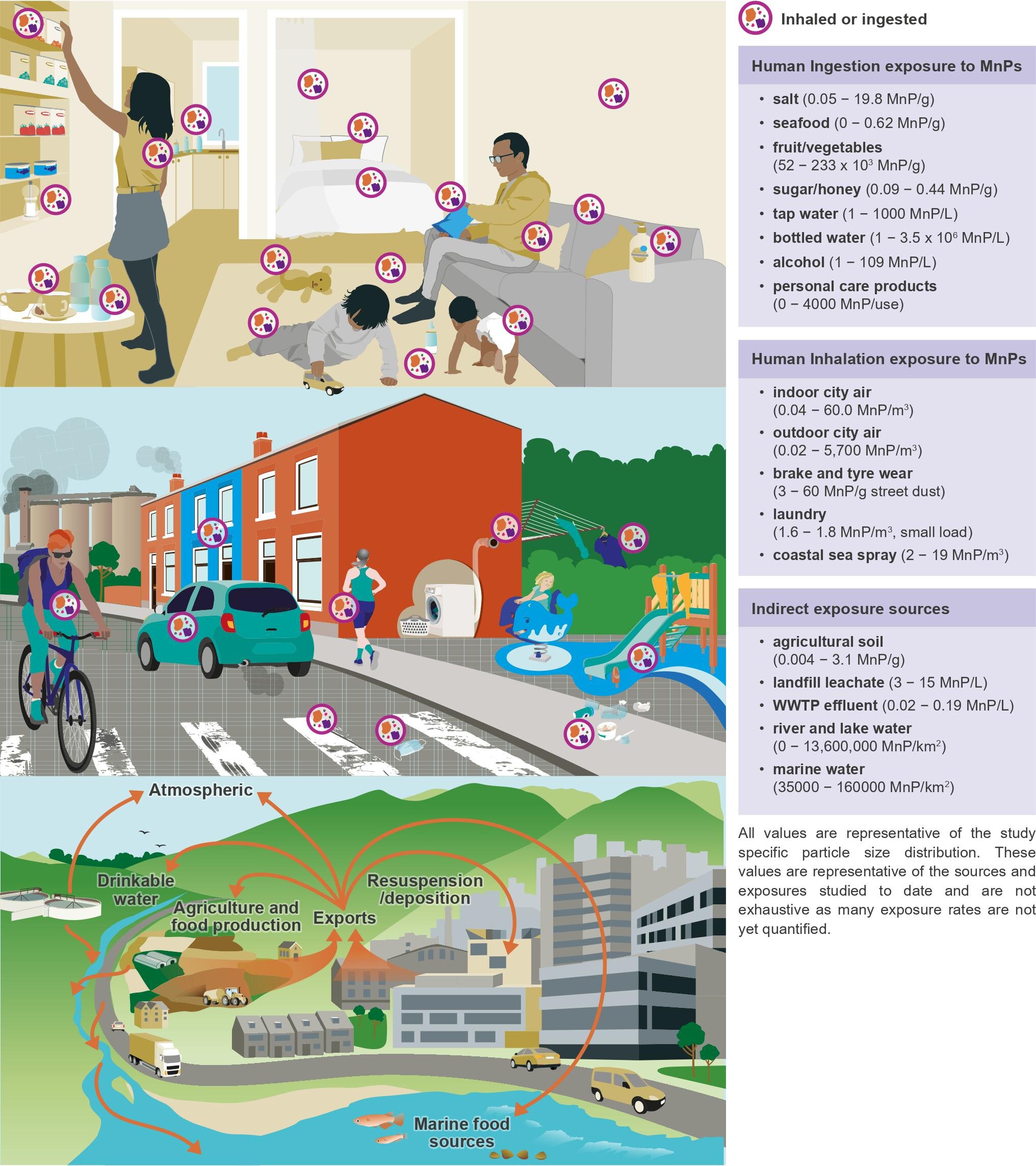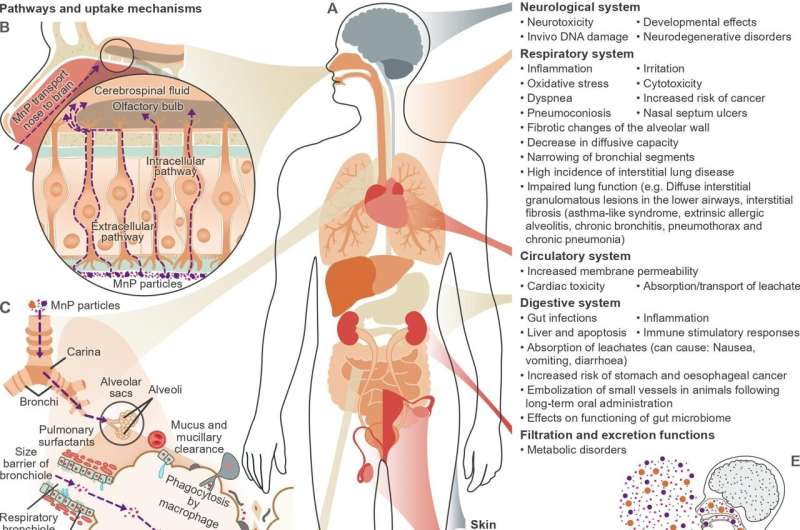Health
Small plastic particles can increase the risk of serious diseases

Human exposure rates are determined by the fate and transport of MnPs in the environment that control the connectivity between spatially and temporally dynamic sources of environmental pollution and human exposure (bottom). Together, these dynamic exposure controls determine the combined uptake of MnPs and their additives that may influence the risk and/or severity of NCDs. The text boxes provide some example exposure ranges associated with different MnP sources. Credit: Cell reports medicine (2024). DOI: 10.1016/j.xcrm.2024.101581
People may be at increased risk of cancer, diabetes, cardiovascular disease and chronic lung disease – as rising global levels of micro- and nanoplastics (MnPs) are absorbed into the human body, a new study reveals.
Non-communicable diseases (NCDs) such as these are related to inflammatory conditions in the organs of the body, where the small particles increase the absorption of MnPs and their washouts into the digestive and respiratory systems, potentially increasing the risk and severity of NCDs in the increase in the future.
And MnP concentrations in infant feces are significantly higher than in adults – possibly because plastic is commonly used in the preparation, presentation and storage of baby food. Young children’s behavior, such as putting objects in their mouths, may also be responsible.
Publishing their findings in Cell reports medicinean international group of researchers is now calling for a global, integrated One Health approach to human health and environmental research that will reveal the environmental mechanisms underlying the increase in human exposure to MnP and its particles associated with non-communicable diseases.
Lead author Professor Stefan Krause from the University of Birmingham said: “Plastic pollution has increased globally, making it crucial that we understand the general health risks associated with MnP exposure.
“We must tackle this pollution at its source to further reduce emissions, as the global spread of MnPs that has already occurred will remain a concern for centuries to come. For this, we need a systematic investigation of the environmental drivers of human MnPs. exposure and their impact on the prevalence and severity of the major NCD groups of cancer, diabetes, cardiovascular disease and chronic lung diseases.”
The researchers emphasize that the relationship between MnPs and NCDs resembles that of other particles, including natural sources such as pollen or man-made pollutants such as diesel exhaust, and MnPs, and artificial nanomaterials, all of which act in a similar biological way.
The body treats these as foreign entities that trigger the same protective mechanisms – risking overwhelming the body’s defenses and increasing the frequency and severity of NCDs.

(A) Hypothetical uptake mechanisms of MnPs across human biological barriers, including via (B) the olfactory bulb, (C) the lung-air barrier, and (D) the gastrointestinal tract, also indicating the systems and organs directly affected by MnPs and the associated associated MnP effects and suspected adverse health effects include NCDs. The putative particle size fractionation caused by differences in the uptake mechanisms (A–D) is highlighted in (E), with larger particles being ingested (up to 130 mm) rather than inhaled (less than 2.5 mm) and only the smallest ( nanoscale) particles that can penetrate the blood-brain barrier. MnP internalized via routes (C) and (D) reaches the broader circulatory system and from there can reach all organs. Credit: Cell reports medicine (2024). DOI: 10.1016/j.xcrm.2024.101581
The incidence of non-communicable diseases is increasing around the world, with the four major types collectively responsible for 71% of all global deaths per year and creating a predicted economic impact of more than $30 trillion over the next twenty years.
Co-author Semira Manaseki-Holland, from the University of Birmingham, said: “We need to better understand how MnPs and non-communicable diseases interact if we are to advance global prevention and treatment efforts towards the Sustainable Development Goal of the UN on reducing premature deaths from non-communicable diseases and other inflammatory conditions by 2030.
“This need is critical in low- and lower-middle-income countries (LMICs), where the prevalence of NCDs is increasing and levels of plastic pollution and exposure are high. Whether we encounter them indoors or outdoors, MnPs likely contribute to global health risks. “
Global pollution trends show that micro- (smaller than 5 mm) and nano-plastic (smaller than 1 µm) are now found everywhere. MnPs have been detected in samples of lungs, blood, breast milk, placenta and feces, confirming that the particles enter the human body from the environment.
People are exposed to MnPs both indoors and outdoors through food, beverage consumption, air, and many other sources, including cosmetics and human care products.
MnPs have been found in fish, salt, beer and plastic beverage bottles or air, where they are released from synthetic clothing materials, plastic fabric bedding during sleep, plastic carpet or furniture. Other sources may include fertilizer, soil, irrigation, and incorporation into food crops or products.
Human exposure to MnPs varies considerably depending on location and exposure mechanism. There is evidence that MnP pollution hotspots in indoor air contain up to 50 times as many particles as outdoors.
Co-author Professor Iseult Lynch, from the University of Birmingham, added: “We need to understand the human health risks associated with MnPs and to do this we will need to understand the environmental controls of individual exposures. This requires environmental and medical scientists. to work very closely together.”
More information:
Stefan Krause et al., The Potential of Micro- and Nanoplastics to Exacerbate Health Impacts and the Global Burden of Non-Communicable Diseases, Cell reports medicine (2024). DOI: 10.1016/j.xcrm.2024.101581
Quote: Tiny plastic particles may increase risk of serious diseases (2024, June 21), retrieved June 23, 2024 from https://medicalxpress.com/news/2024-06-tiny-plastic-particles-major-diseases.html
This document is copyrighted. Except for fair dealing purposes for the purpose of private study or research, no part may be reproduced without written permission. The content is provided for informational purposes only.









